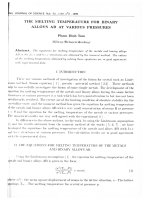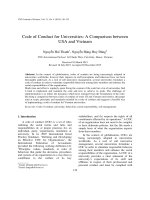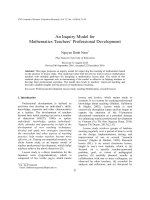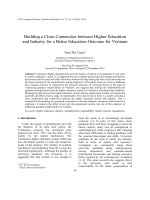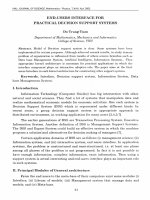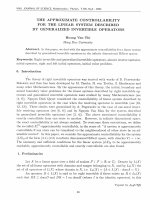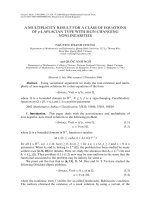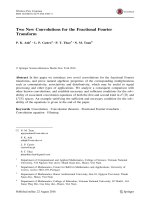DSpace at VNU: Straight-line path approximation for high energy elastic and inelastic scattering in quantum gravity
Bạn đang xem bản rút gọn của tài liệu. Xem và tải ngay bản đầy đủ của tài liệu tại đây (148.74 KB, 7 trang )
Eur. Phys. J. C 16, 547–553 (2000)
Digital Object Identifier (DOI) 10.1007/s100520000328
THE EUROPEAN
PHYSICAL JOURNAL C
c
Societ`
a Italiana di Fisica
Springer-Verlag 2000
Straight-line path approximation for high energy elastic
and inelastic scattering in quantum gravity
N.S. Hana
Institute of Theoretical Physics, Chinese Academy of Sciences, P.O. Box 2735, Beijing 100080, P.R. China
Received: 6 December 1999 / Published online: 6 July 2000 – c Springer-Verlag 2000
Abstract. The asymptotic behavior of Planck energy elastic and inelastic amplitudes in quantum gravity
is studied by means of the functional integration method. A straight-line path approximation is used to
calculate the functional integrals which arise. Closed relativistically invariant expressions are obtained
for the two “nucleons” elastic and inelastic amplitudes including the radiative corrections. Under the
requirement of “softness” of the secondary gravitons a Poisson distribution for the number of particles
emitted in the collision is found.
1 Introduction
Planck energy gravitational scattering has received considerable attention in recent years because of its relation to
fundamental problems like the strong gravitational forces
near black holes, a string modification of the theory of
gravity and some other effects of quantum gravity [1–14].
In a previous work [14] we have developed a method for
constructing a scattering amplitude in quantum gravity by
means of a functional integral used effectively in quantum
electrodynamics [16, 17, 34, 19–24].
A straight-line path approximation is formulated that
can be used effectively to calculate the functional integrals that occur. It is shown that in the limit of asymp2
totically high energy s
MPL
t, where MPL is the
Planck mass, at fixed momentum transfer t the elastic
scattering amplitude of two “nucleons” has the form of a
Glauber representation [14] with an eikonal function depending on the energy. A similar result is obtained by the
“shock-wave method” proposed by ’t Hooft [1], and by
the method of effective topological theory in the Planck
limit proposed by Verlinde and Verlinde [5] and by the
summing of Feynman diagrams in the eikonal approximation [6]. The main advantage of the proposed approach
over the others is the possibility of performing calculations in compact form and the correct structure of the
Green’s function and amplitudes etc. is not destroyed by
approximations in the process of the calculations. In the
present report we would like to apply the above method to
study multiple bremsstrahlumg soft gravitons in collisions
which are well known to be an important phenomenon in
high energy particle collisions physics [25–27]. This problem has recently seen a renewal of interest in the context
a
Permanent address: Department of Theoretical Physics,
Vietnam National University, P.O. Box 600, BoHo, Hanoi
10000, Vietnam; e-mail:
of the gravitational production of particles in an expanding universe [28]. This letter is organized as follows. In
Sect. 2 we determine the elastic scattering amplitude of
two particles in terms of the functional integral, remove
divergences by the mass renormalization of the scattered
“nucleons”, and then, using the straight-line path approximation, we calculate the contributions of the radiative
corrections to the Planck energy scattering amplitude. In
Sect. 3 the problem of the multiple production of “soft”
gravitons in high energy two “nucleon” collisions is intepreted by analogy with the bremsstrahlung emission of
“soft” particles in electrodynamics; the inelastic scattering
amplitude can be obtained by generalizing the procedure
presented in Sect. 2. In Sect. 4 we consider the differential
cross section of inelastic processes, and investigate the behavior of the distribution of secondary gravitons produced
in high energy “nucleon” collisions. Finally in Sect. 5, we
draw our conclusions.
2 Elastic scattering amplitudes
We consider the scattering of two scalar particles of the
field ϕ(x), a “nucleon” at high energies, at fixed transfer
in quantum gravity. To construct the representation of the
elastic scattering amplitude in the framework of the functional approach we first find the Green’s function of the
two “nucleons” case, then we must go over in the Green’s
function obtained to the mass shell respectively to the
external ends of the “nucleon” line. Therefore, using the
method of variational derivatives we shall determine the
elastic scattering amplitude
i(2π)4 δ 4 (p1 + p2 − q1 − q2 )T (p1 , p2 ; q1 , q2 )
548
N.S. Han: Straight-line path approximation for high energy elastic and inelastic scattering in quantum gravity
=
lim
p2i ,qi2 →m2
2
[δ 4 ν]ττ1 is a volume element of the functional space of the
four dimensional functions ν(η) in the interval τ1 ≤ η ≤ τ2
and S0 (h) is the vacuum expectation of the S-matrix in
the external field hext
µν . We shall henceforth disregard the
contribution of the vacuum loops and put S0 (h) = 1. The
function Dαβγδ (x) is the propagator of the free graviton
field,
(qi2 − m2 )(p2i − m2 )
i=1,2
d4 xi d4 yi ei (pi xi − qi yi )
×
i
2
× exp
d4 ξ1 d4 ξ2
δ
δhαβ (ξ1 )
δ
.G(x1 , y1 |h)
(ξ1 − ξ2 ) γδ
×D
δh (ξ2 )
×G(x2 , y2 |h)S0 (h))|h=0 ,
Dαβγδ (x) = ωαβ,γδ
αβγδ
(2.1)
where G(x, y|hµν ) is the Green’s function of the “nucleon”
in an external linearized gravitational field. Note that for
the gravitational field in the first-order formalism one can
write down an exact interaction Lagrangian that contains
only a single vertex [14],
L(x) = L0,ϕ (x) + L0,grav. (x) + Lint (x),
where
1 µ
[∂ ϕ(x)∂µ ϕ(x) − m2 ϕ2 (x)],
2
L0ϕ (x) =
κ
Lint (x) = − hµν (x)Tµν (x),
2
and Tµν (x) = ∂µ ϕ(x)∂ν ϕ(x)(1/2)ηµν [∂ σ ϕ(x)∂σ ϕ(x)
−m2 ϕ2 (x)] is the energy-momentum tensor of the scalar
field ϕ(x).
The quantity
g
µν
=η
µν
+ κh
G(x, y|hµν ) = i
×
[δ
4
ν]τ0
∞
0
exp iκ
×δ 4 x − y − 2
τ
0
2
dτ e−im
τ
0
Jµν h
τ
Substituting (2.2) to (2.1) and making a number of substitutions of the functional variables [14], we obtain a closed
expression for the two-particle scattering amplitude in the
form of functional integrals:
T (p1 , p2 ; q1 , q2 ) = (κ2 )
d4 x1 d4 x2 ei(p1 −q1 )x1 +i(p2 −q2 )x2
×Dαβγδ (x)
[δ 4 ν2 ]∞
−∞
×[p1 + q1 + 2ν1 (0)]α [p1 + q1 + 2ν1 (0)]β
×[p2 + q2 + 2ν2 (0)]γ [p2 + q2 + 2ν2 (0)]δ []
×
1
0
dλ exp
τi
0
ν(η)dη .
0
[δ 4 ν]ττ1 =
δ 4 ν exp [] − i
δ 4 ν exp [] − i
,
(2.5)
∞
−∞
dξ[pi θ(ξ) + qi θ(−ξ) + ν(ξ)]µ
(2.2)
× exp 2ik pi ξi θ(ξ) + qi ξi θ(−ξ)
+
ξ
0
νi (η)dη
,
(2.6)
dz1 dz2 Jiµν (z1 )Dµνασ (z1 − z2 )Jkασ (z2 );
i, k = 1, 2.
νi (η)dη , (2.3)
and
2
−∞
δi m2 dξ
where the quantity Jiµν (k; pi , qi |νi ) is a conserving transition current and is given by
Ji .D.Jk =
ξ
∞
J1 DJ2
× [pi θ(ξ) + qi θ(−ξ) + ν(ξ)]ν
dξ(νµ (ξ)νν (ξ))
× δ z − xi + 2pi ξ + 2
1 2
iκ 2iλeikx
2
d4 kJi DJi − i
The coupling constant κ is related to Newton’s constant
of gravitation G by κ2 = 16πG. In (2.2) we use the notation Ji h = hµν (z)Jµν (z) (i = 1, 2), and Jµν (z) is the
current of the “nucleon” defined by
Jµν (z) =
[δ 4 ν1 ]∞
−∞
Jiµν (k; pi , qi |νi ) = 4
µν
(2.4)
ηµν = (1, −1, −1, −1).
i=1,2
in the form of functional integrals was found in [14]. Now,
eikx
d4 k,
k 2 − µ2 + i
ωαβ,γδ = (ηαγ ηβδ + ηαδ ηβγ − ηαβ ηγδ ),
×
µν
i
(2π)4
τ2 2
ν (η) η d4 η
τ1 µ
.
2
τ
ν 2 (η) η d4 η
τ1 µ
The scattering amplitude (2.5) is interpreted as the residue
of the two-particle Green’s function (2.1) at the poles corresponding to the “nucleon” ends. The factor of the type
exp −(iκ2 /2) i=1,2 Ji DJi of (2.5) takes into account
the radiative corrections to the scattered nucleons, while
describes
virtual-graviton
exp iκ2 iλeikx J1 DJ2
N.S. Han: Straight-line path approximation for high energy elastic and inelastic scattering in quantum gravity
exchange among them. The integral with respect to dλ
ensures subtraction of the contribution of the freely propagating particles from the matrix element. The functional
variables ν1 (η) and ν2 (η), formally introduced for obtaining the solution for the Green’s function, describe the
deviation of a particle trajectory from the straight-line
paths. The functional with respect to [δ 4 νi ] (i = 1, 2)
corresponds to summation over all possible trajectories
of the colliding particles. Expanding the expression (2.5)
with respect to the coupling constant κ2 and taking the
functional integrals with νi (η), we obtain the well-known
series of usual perturbation theory for two-particle scattering. From the consideration of the integrals over ξ1 and
ξ2 for exp −(iκ2 /2) i=1,2 Ji DJi it is seen that the
radiative corrections result in divergent expressions of the
type δi m2 × (A → ∞). To regularize them, it is necessary to renormalize the mass, that is, to separate from
exp −(iκ2 /2) i=1,2 Ji DJi the terms δi m2 × (A →
∞); i = 1, 2, after which we go over in (2.5) to the observed masses mi 2R = mi 20 + δi m2 .
Hitherto, no assumptions have been made. To advance
in the investigation of the elastic amplitude we make the
following assumption. We assume that all gravitons are
“soft”, i.e. their four-momenta are small compored with
the momentum of the two “nucleon” system as well as
the momentum between them and satifies the following
condition:
1
√
s
N
k0i
1;
N
ki⊥ |
|p1⊥ − q1⊥ | ≈ |p2⊥ − q2⊥ |,
(2.7)
i=1
where the particle momentum components are given in the
centre of mass system, the moment of the intial “nucleons” being taken along the z axis. This means that in the
propagators we can neglect terms of the form i=j ki kj
compared with 2p i ki , i.e. we can make the substitution
−1
m2 −
2
n
p−
ki
n
→ 2p
i=1
n
ki −
i=1
,
i=1
[δ 4 ν]F1 [ν] exp {F2 [ν]} = F1 [ν] exp F2 [ν] , ) (2.8)
[δ 4 ν]Fi [ν];
i = 1, 2.
In this approximation, (2.8), the scattering amplitude of
the elastic process takes the form
1
0
d4 xei(p1 −q1 )x
dλ
× exp {iλχ(x; p1 , p2 , q1 , q2 )} ,
(2.9)
where
∆(x; p1 , p2 ; q1 , q2 ) =
d4 kDµνρσ (k) exp[ikx]
×[k + p1 + q1 ]µ [k + p1 + q1 ]ν
×[−k + p2 + q2 ]ρ [−k + p2 + q2 ]σ ,
Jiµν (k, pi , qi ) =
(2.10)
µν
[δ 4 νi ]∞
−∞ Ji (k, pi , qi |νi )
(2pi + k)µ (2pi + k)ν
2pi k + k 2 + i
(2qi − k)µ (2qi − k)ν
,
−
2q1 k − k 2 − i
=
χ(x; p1 , p2 , q1 , q2 ) = −
iκ2
(2π)4
(2.11)
d4 keikx Dµνρσ (k)
×J1µν (−k, p1 , q1 )J2ρσ (k, p1 , q2 ),
(2.12)
J1µν (−k, p1 , q1 )J2ρσ (k, p2 , q2 )
4
∞
[δ 4 ν1 ]∞
−∞ [δ ν2 ]−∞
×J1µν (−k, p1 , q1 |ν1 )J2µν (k, p2 , q2 |ν2 )
(2p1 + k)µ (2p1 + k)ν
(2q1 − k)µ (2q1 − k)ν
=
−
2
2p1 k + k + i
2q1 k − k 2 − i
(2p2 − k)ρ (2p2 − k)σ
×
2p2 k − k 2 − i
(2q2 + k)ρ (2q2 + k)σ
,
(2.13)
−
2q2 k + k 2 + i
−1
ki2
where p is the momentum of one of the “nucleons” and
ki are the momenta of the gravitons. This approximation,
which is called the straight-line path approximation, corresponds [14–17, 34, 19–21] to the approximate calculation
of the Feynman path integrals in (2.5) in accordance with
the rule
Fi [ν] =
×∆(x; p1 , p2 ; q1 , q2 )
=
i=1
|
T (p1 , p2 ; q1 , q2 ) = κ2 R(t)
549
2
R(t) = exp
i=1
iκ2
2(2π)2
d4 kDµνρσ (k)
× Jiµν (k; pi , qi )Jiρσ (−k; pi , qi ) − δi m2 (A → ∞)
= exp
iκ2
2(2π)2
2
d4 kDµνρσ (k)
i=1
(2pi + k)µ (2pi + k)ν (2pi + k)ρ (2pi + k)σ
×
(2pi k + k 2 )2
(2qi + k)µ (2qi + k)ν (2qi + k)ρ (2qi + k)σ
+
(2qi k + k 2 )2
−
2(2pi + k)µ (2pi + k)ν (2qi + k)ρ (2qi + k)σ
(2pi k + k 2 )(2qi k + k 2 )
.
(2.14)
550
N.S. Han: Straight-line path approximation for high energy elastic and inelastic scattering in quantum gravity
It is interesting to note that the contribution of the radiative corrections (2.14) can be factorized in the given approximation of (2.8) in the form of a factor R(t). A similar
factorization of the contributions of radiative corections
occurs in the case of quantum electrodynamics [32]. In
the calculation of R(t) we must take care of the infrared
divergences which we have treated above by the insertion
of a small graviton mass µ. Evaluating the integrals in
(2.14) for the radiative corrections (2.14) we obtain the
following expression [15]:
m2
m2
κ 2 m2 t
ln 2 −
2
2(2π)
µ
−t(4m2 − t)
√
√
√
m2 4m2 − t
4m2 − t + −t
× ln
ln √
+ Φ(z1 )
√
µ2
4m2 − t − −t
R(t)t<0 = exp
−Φ(z2 )
,
(2.15)
z
dy
ln |1 − y|;
y
0
√
√
4m2 − t + t
√
z1 =
;
2 4m2 − t
√
√
4m2 − t − t
√
z1 =
.
2 4m2 − t
Φ(z) =
Let us consider the asymptotic behavior of the scattering
amplitude (2.9) at high energy s → ∞ at fixed momentum
transfer t (forward scattering). We make the calculation in
the centre of mass system of the colliding particles: p1 =
−p2 = p, and we direct the z axis along the momentum
2
p1 . In the high energy limit s
MPL
t where MPL is
the Planck mass, at fixed momentum transfer t limited by
the condition |t|
m2 , the values of the eikonal function
and radiative corrections are
χ(x⊥ ) =
κ2 .s
K0 (µ|x⊥ ),
2π
2Gm2
π
ln
m2
1
+
µ2
2
,
(2.16)
where µ is a graviton mass which serves as an infrared cutoff. Thus, in the given asymptotic limit the expression for
the elastic scattering amplitude (2.8) has the form1 [31]
T (s, t) = −2zi(s − u)f (t)eat ,
(2.17)
1
Allowance for the identity of the “nucleons” leads to terms
that vanish in the limit s → ∞ and for t fixed when expression
(2.17) is symmetrized.
d2 x⊥ e−iq⊥ x⊥ (e−iχ(x⊥ ) − 1)
(2.18)
is the elastic scattering amplitude without taking into
account radiations corrections, and t = −q⊥ 2 . Formula
(2.17) shows that allowance for radiative effects leads to a
diffraction behavior of the high energy small-angle scattering amplitude. The forces due to the change of graviton
between the “nucleons” obviously have a range h
¯ /µc, it
being assumed that h
¯ /µc
κ(¯
h/mc). Thus, in the region
µ2 ≤ |t| ≤ m2 , allowance for graviton exchange becomes
important and leads to an eikonal structure of f (t).
3 Inelastic amplitudes
Here we shall consider a generalization of the above
method to the construction of inelastic amplitudes. The
production of secondary particles in the collision of two
“nucleons” is intepreted by analogy with bremsstrahlung
emission of soft particles in electrodynamics, i.e. the colliding “nucleons” interact by changing virtual quanta of
the field hµν and emit at the same time secondary particles [19, 25]. The amplitude of the above inelastic process
can be obtained as follows. We first construct the scattering amplitude T (p1 , p2 ; q1 , q2 |hext ) of the two “nucleons”
in the presence of the external classical field hext
µν . The
quantity T (p1 , p2 ; q1 , q2 |hext ) can be obtained by expression (2.1) in which one must set h = hext
µν after variational
derivatives have been taken. As a result, we have
T (p1 , p2 ; q1 , q2 |hext )
= (κ2 )
d4 x1 d4 x2 ei(p1 −q1 )x1 +i(p2 −q2 )x2
×Dαβγδ (x)
[δ 4 ν1 ]∞
−∞
[δ 4 ν2 ]∞
−∞
×[p1 + q1 + 2ν1 (0)]α [p1 + q1 + 2ν1 (0)]β
×[p2 + q2 + 2ν2 (0)]γ [p2 + q2 + 2ν2 (0)]δ
1
0
dλ exp
1 2
iκ 2iλeikx
2
d4 kJi DJi − i
×
where K0 (µ|x⊥ ) is the MacDonald function of zeroth order, and
1
2
f (t) =
×
R(t) = exp(at),
a=
where
i=1,2
J1 DJ2
∞
−∞
δi m2 dξ
ilx1
d4 lhext
+ j2 (l)eilx2 ] . (3.1)
µν (l)[J1 (l)e
× exp −iκ
Further we apply to T (p1 , p2 ; q1 , q2 |hext ) the operator
N
i
µν (ki )
√
(2π)3/2 2k0 i
i=1
δ
δhext
µν (ki )
;
(3.2)
then setting hext
µν = 0, we obtained the amplitude for the
production of N gravitons in the collision of two “nucleons”:
(2π)4 δ 4
i=N
p1 + p 2 − q 1 − q 2 −
ki
i=1
N.S. Han: Straight-line path approximation for high energy elastic and inelastic scattering in quantum gravity
×iTinel (p1 , p2 ; q1 , q2 |k1 , k2 , ...kN )
= (κ2 )
×
d4 x1 d4 x2 ei(p1 −q1 )x1 +i(p2 −q2 )x2 Dαβγδ (x)
[δ 4 ν1 ]∞
−∞
[δ 4 ν2 ]∞
−∞ [p1 + q1 + 2ν1 (0)]α
×[p1 + q1 + 2ν1 (0)]β [p2 + q2 + 2ν2 (0)]γ
×[p2 + q2 + 2ν2 (0)]δ ]
1
1
×
dλ exp
iκ2 2iλeikx J1 DJ2
2
0
d4 kJi DJi − i
δi m2 dξ
−∞
i=1,2
p1 + p 2 − q 1 − q 2 −
n
d3 ki 1
1 d3 q1 d3 q2 1
.
,
6
(2π) 2q10 2q20 n! i=1 2k0i (2π)3
n1
×
×
0
exp −
× exp −
κ2
2
iλκ
(2π)4
2
t=∆ =
q 1 − p1 +
ki
i=1
2
i=n2
=
q 2 − p2 +
ki
,
(4.3)
i=1
n1 + n2 = N.
Using (4.2) and the transformation
δ4
d4 kDµνρσ (k)eikx J1µν (−k)J2ρσ (k)
=
(DJi − δm2i )
n1
p1 + p 2 − q 1 − q 2 −
d4 ∆δ 4
n2
ki −
i=1
n1
p1 − q 1 −
ki
i=1
ki + ∆
i=1
i=1
×δ 4
N
i
1
µν (ki )
√
×√
(iκ)
N ! i=1 (2π)3/2 2k0 i
×[J1µν (ki )eiki x/2 + J2µν (ki )e−iki x/2 ].
2
i=n1
2
d4 xei(p1 −q1 )x
×[k + p1 + q1 ]µ [k + p1 + q1 ]ν Dµνρσ (x)
×[−k + p2 + q2 ]ρ [−k + p2 + q2 ]σ
2
(4.2)
where
where
is the polarization tensor of a graviton with
momentum ki . We have introduced in (3.3) the factor
N !1/2 which takes into account the fact that the emitted gravitons are identical. In the approximation (2.8) the
scattering amplitude of the inelastic process (2.16) takes
the form
1
µν
i
µν (ki )J2 (k, p2 , q2 ),
i=1
i=1
(3.3)
n2
µν
i
µν (ki )J1 (k, p1 , q1 )
i
µν (ki )
Tinel (p1 , p2 ; q1 , q2 , k1 |k2 , ...kN ) =
(4.1)
Tinel (p1 , p2 ; q1 , q2 , k1 , k2 , ...kN ) = Tel (p1 , p2 ; q1 , q2 )
N
i
1
µν (ki )
√
×√
(−iκ)
N ! i=1 (2π)3/2 2k0 i
×[J1 (ki )eiki x1 + j2 (ki )eiki x2 ],
ki
i=1
where s = (p1 + p2 )2 . In what follows we shall be interested in the asymptotic behavior of the differential cross
sections for the production processes of “soft” gravitons
whose momenta are restricted by the conditions (2.7). As
we shall show we can neglect the interference terms in this
case in the inelastic scattering amplitude (3.3) i.e.
∞
×
N
×δ 4
×
551
n2
p2 − q 2 −
ki − ∆ ,
(4.4)
i=1
(3.4)
In (3.4) we have taken into account the law of conservation of energy-momentum. We have separated out the δ 4 i=N
function δ 4 p1 + p2 − q1 − q2 − i=1 ki . Note that by
virtue of our assumption (2.7) that the created gravitons
have small momenta we can set ki = 0(i = 1, 2, 3, ..., N ) in
(3.4) in the expressions exp(±iki x/2). In other words, we
consider the production of “soft” gravitons which do not
affect the motion of the scattered high energy “nucleons”.
4 Asymptotic behavior of the differential
cross section for multiple production
The differential cross section for the production of N
gravitons in a collision of two “nucleons” is given by
1
|Tinel (p1 , p2 ; q1 , q2 |k1 , k2 , ..., kN )|2
dσn =
2 s(s − 4m2 )
we can represent the differential cross section for graviton
production (4.1) in the form
(dσ)n1 ,n2 =
1 d4 ∆
|Tel (s, t)|2 Wn1 (p1 , ∆)
2s (2π)4
×Wn2 (p2 , −∆),
(4.5)
where Tel (p1 , p2 ; q1 , q2 ) = Tel (s, t) is defined by (2.9), and
Wni (pi , ∆) =
2π
ni
d3 qi 4
δ
2qi0
pi − q i −
ni
×
d3 ki −κ2 µν
|J (k, pi , qi )|2 ,
3 i
2k
(2π)
0i
i=1
ki + ∆
i=1
(4.6)
and there is a similar expression for the Wn2 (p2 , −∆) The
quantities Wn1 (p1 , ∆) and Wn2 (p2 , −∆) depend on the
variables
t = ∆2 ,
r1 = p1 ∆,
552
N.S. Han: Straight-line path approximation for high energy elastic and inelastic scattering in quantum gravity
t = ∆2 ,
r2 = p2 ∆,
(4.7)
respectively. Using the variables (4.7), we transform the
volume element d4 ∆ to the form
4π
d4 ∆ =
s(s − 4m2 )
dtdr1 dr2
dφ
,
2π
(4.8)
The integration (4.15) is effectively restricted by the conditions: |kz | ≤ Rz , |kz | ≤ R⊥ . The quantity n(s, t) play
the role of the average number of particles in a collision
of two “nucleons” at high energy s −→ ∞ and fixed t. In
general, n(s, t) depends on the method chosen to cut off
the integrals over the momenta of the emitted gravitons
at the upper limit [23]. In particular, if
where φ is the azimuthal angle, the physical domain of the
integration variables being given by the inequalities
−t ≤ 2r1 ≤ s,
2
R⊥
∼ m2 ;
ln(m2 /µ2 )
−t ≤ 2r2 ≤ s,
s ≥ m2 ;
n1 ,n2
−→
−s ≤ t ≤ 0.
(4.9)
1
|f (t)|2 ωn1 (s, t)ωn2 (s, t), (4.10)
4π
where
ωn (s, t) =
=
eat
π
drWn (s, t)
n
1 at i d3 ki (−κ2 ) µν
e
|Ji (k, pi , qi )|2 . (4.11)
3
n!
2k
(2π)
0i
i=1
The domain of integration Ωp over the moment of the
secondary gravitons is given by
n
−t ≤ 2p
n
ki −
2
∆−
i=1
≤ s,
(4.12)
i=1
n
i=1
or, since in our case (∆ −
tion
2
ki ) ≈ ∆2 , by the condi-
n
ki ≤ s + t.
0 ≤ 2p
Let now consider the approximation in which one can neglect the total momentum of the emitted gravitons in accordance with the “softness” condition (2.7). In this approximation the expression (4.11) takes the form of a Poisson distribution,
1 at
e [n(s, t)]n ,
n!
(4.14)
where
n(s, t) = −
κ2
(2π)3
α = Rz /p0 ,
(4.16)
using formula (2.17) for Jiµν (k, pi , qi ), we find
n(s, t) = −bt,
d3 ki µν
|J (k, pi , qi )|2 .
2k0i i
b=
4Gm2
π
ln
m2
1
+
2
µ
2
(4.17)
,
(4.18)
which is twice the “nucleon” parameter (2.16) of the
diffraction exponent function. Note also that the equation
2a = b holds in the infrared asymptotic limit µ −→ 0.
In this case the dependence on t cancels as a result of
the summation in (4.11) over the number of all the emitted gravitons, and this leads to the disappearance of the
diffraction peak in the differential cross section. A similar behavior was noted in [34] and is analogous to the
self-similar behavior of the deep inelastic processes of the
hadron interaction at high energy [33, 34].
As we have mentioned, we have neglected the interference terms in the derivation (4.2); if we allowed for these
terms in the exponent for n(s, t) we should obtain terms
of the type
κ2
(2π)
d3 k µν
J (−k, p1 , q1 )J2ρσ (k, p2 , q2 ),
k0 1
(4.19)
which are infinitesimally small in the high energy limit
s −→ ∞ with fixed t provided the conditions (4.16) above
are satisfied [23].
(4.13)
i=1
ωn (s, t) =
ln(1/α)2 ;
µ2 /m2 ,
|t| ≤ m2 ,
In what follows we shall be interested in the differential
cross section (dσ/dt)n1 ,n2 in the limit s −→ ∞ with t
fixed. Integrating (4.6) over dr1 and dr2 and using formula
(2.17), and for t fixed, |t|
m2 ; s −→ ∞, we obtain the
expression
dσ
dt
α2
1
(4.15)
5 Conclusions
In the framework of the functional integration method the
asymptotic behavior of Planck energy elastic and inelastic amplitudes in quantum gravity is studied. A straightline path approximation is used to calculate the functional integrals which arise. Closed relativistically invariant expressions are obtained for the two “nucleons” elastic
and inelastic amplitudes including the radiative correction contributions. It is interesting to note that the total differential cross section summed over all the emitted
gravitons may have no pronounced diffraction peak in a
certain domain of momentum transfer. In this connection
N.S. Han: Straight-line path approximation for high energy elastic and inelastic scattering in quantum gravity
an analogy should be indicated with the automodel behavior of the cross section of high energy deep inelastic
interactions of hadrons with leptons. Under the requirement of the “softness” of graviton production, the high
energy two “nucleon” collision is considered by analogy
with bremsstrahlung emission of soft particles in electrodynamics. The Poisson nature of the multiplicity distribution of secondary gravitons for fixed momentum transfers
in high energy “nucleon” collisions is given.
The straight-line path approximation used in this work
corresponds to a physical picture in which colliding high
energy “nucleons” at the interaction receive a small recoil
connected with the emission of “soft” gravitons and retain
their individuality.
Acknowledgements. We are grateful to Profs. B.M. Barbashov,
A.I. Andreev, A.V. Efremov, V.V. Nesterenko, V.N. Pervushin
for useful discussions and Prof. G. Veneziano for suggesting
this problem and encouragement. I would also like to express
sincere thanks to Profs. Zhao-bin Su, and Tao Xiang for support during presence at the Institute of Theoretical Physics
- Chinese Academy of Sciences (ITP-CAS), in Beijing, and
for their warm hospitality. This work was supported in part
by ITP-CAS, Third World Academy of Sciences and Vietnam
National Research Programme in National Science.
References
1. G. ’t Hooft, Phys. Lett. B 198, 61 (1987)
2. D. Amati, M. Ciafaloni, G. Veneziano, Int. J. Mod. Phys.
A 3, 1615 (1988)
3. D. Amati, M. Ciafaloni, G. Veneziano, Nucl. Phys. B 347,
550 (1990)
4. D. Amati, M. Ciafaloni, G. Veneziano, Phys. Lett. B 197,
81 (1987)
5. E. Verlinde, H. Verlinde, Nucl. Phys. B 371, 246 (1992)
6. D. Kabat, M. Ortiz, Nucl. Phys. B 388, 570 (1992)
7. M. Fabbrichesi et al., Nucl. Phys. B 419, 147 (1994)
8. I. Muzinich, M. Soldate, Phys. Rev. D 37, 353 (1988)
553
9. C.O. Lousto, N. Sanchez, Phys. Lett. 232, 462 (1989)
10. I.Ya. Aref’eva, K.S. Viswanathan, I.V. Volovich, Nucl.
Phys. B 452, 346 (1995)
11. T. Kubota, H. Takashino, Prog. Theor. Phys. 94, 637
(1995)
12. S. Kar, J. Manharana, Int. J. Mod. Phys. A 10, 2733
(1995)
13. M. Zeni, Class. Quantum Grav. 10, 905 (1993)
14. Nguyen Suan Han, E. Ponna, Nuovo Cimento A 110, 459
(1997)
15. Nguyen Suan Han, ICTP, IC/IR/99/4, Trieste (1999)
16. B.M. Barbashov et al. Phys. Lett. B 33, 419 (1970)
17. B.M. Barbashov et al., Phys. Lett. B 33, 484 (1970)
18. V.A. Matveev, A.N. Tavkhelidze, Teor. Mat. Fiz. 9, 44
(1971)
19. Nguyen Suan Han, V.V. Nesterenko, Teor. Mat. Fiz. 24,
768 (1975)
20. Nguyen Suan Han, V.N. Pervushin, Teor. Mat. Fiz. 29,
1003 (1976)
21. B.M. Barbashov, JEPT 48, 607 (1965)
22. B.M. Barbashov, M.K. Volkov, JEPT 50, 660 (1966)
23. B.M. Barbashov et al., Nuovo Cimento A 4, 731 (1971)
24. G.A. Milekhin, E.S. Fradkin, JEPT 45, 1926 (1963)
25. S.N. Gupta, Phys. Rev. 98, 1502 (1955)
26. Ya.B. Zel’dovich, A.A. Starovinsky, Sov. Phys. JEPT 34,
1159 (1972)
27. A.A. Grib, S. G. Mamaev, V.M. Mostopanenko, Vacuum quantum effects in strong fields (Energoatomizdat,
Moscow 1988)
28. G. Felder, L. Kofman, A. Linder, hep-ph/9909508, 1999
and references therein
29. S. Weinberg, Phys. Rev. B 140 516 (1965)
30. B.M. Barker, S.N. Gupta, J. Kaskas, Phys. Rev. 182, 1391
(1969)
31. R.J. Glauber, Lectures in theoretical physics, vol. 1, p.
315 (New York 1959)
32. D.R. Yennie, S.C. Frautschi, H. Sura, Ann. Phys. 13, 379
(1961)
33. A. Markov, The neutrino (Nauka, Moscow 1964)
34. V.A. Matveev, R. Muradyan, Tavkhelide, Sov. J. Part.
Nucl. 2, 1 (1972)

